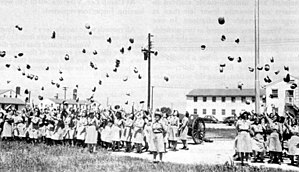Camp Atterbury
| Camp Atterbury | |
|---|---|
| Bartholomew / Brown / Johnson counties, near Edinburgh, Indiana |
|

Mass-enlistment ceremony of WACs, 10 August 1943, at Camp Atterbury, Indiana
|
|
| Type | Military Training Base |
| Site information | |
| Controlled by | United States |
| Site history | |
| Built | 1941–1942 |
| In use | 1942–1946, 1950-1954, 1969 – present. |
Camp Atterbury, near Edinburgh, Indiana, USA, is a training base of the Indiana National Guard. It was planned just months before the U.S. entry into World War II. Originally surveyed and researched by the Hurd Company, the present site was recommended to Congress in 1941. Construction commenced shortly after the attack on Pearl Harbor. More than 1,500 wood frame buildings were constructed, sized to hold more than one army infantry division. It also contained the 47-building, (concrete block, 2-story) Wakeman General and Convalescent Hospital, the largest hospital of its kind in the US in the 1940s. It was known for its progressive plastic eye replacements. During World War II, the U.S. 39th Evacuation Hospital, the 101st Infantry Battalion (Separate) and four U.S. Army infantry divisions, the 30th, 83rd, 92nd, and 106th, trained here. The 106th left Camp Atterbury on 9 October 1944 and two months later was on the front lines, crossing into Belgium on 10 December 1944. Spread over a 28-mile (45 km) front, they bore the brunt of the Battle of the Bulge with more than 7,000 total combat-related casualties (combined missing, killed, or wounded in action.)
The camp was named for William Wallace Atterbury (1866–1935), an executive of the Pennsylvania Railroad who ultimately became the railroad's president. Upon American entry into World War I, Atterbury, then a PRR vice-president, was commissioned into the U.S. Army as a Brigadier General to oversee the construction and operation of U.S. military railways in France, between August 1917 and May 1919.
...
Wikipedia
